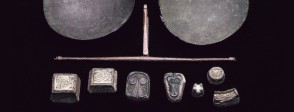Start by discussing exchange and display.
Explain that at first the Vikings did not use money. Discuss with your students what they use money for, and what they bought most recently. Ask how Viking people could get the things they needed if they could not buy them with money. Discuss barter and exchange.
Explain that although the Vikings did not use money, some Vikings were richer than others. Ask your students how these Vikings might have become rich and how they might show they were rich. Show students some of the gold and silver objects in the British Museum Vikings tour in For the classroom and discuss how, by wearing their riches as jewellery, Vikings could show off their wealth and keep it safe by carrying it around with them.
After students are familiar with silver as the basis of exchange and wealth, focus on the scales themselves.
Show students the set of scales and weights in For the classroom. Ask them what they think they are and to draw or explain how the scales and weights were used – you could try some practical balancing activities here. Ask students why the Viking traders weighed out silver objects and coins when they were trading and discuss how this established value.
Give the students pictures of the weights, Viking commodities such as fur, walrus ivory and silver objects of various sizes. These could be printed from websites – see A bigger picture and For the classroom – or students could research and draw them themselves or model them using clay, plasticine and kitchen foil. Ask the students to work in threes to role-play Viking trade using the pictures to represent objects. Two students would be in role as traders and the third in role as the scales, using their hands as balances. Challenge students with large pieces of silver to trade for small quantities, and discuss how traders would chop up silver into smaller pieces.
Students could try building their own working balance scales. These can be made quite simply using household materials; there are links to instruction videos in For the classroom.
Here are two wider historical enquiries.
How did the Vikings travel for trade?
On a world map ask students to identify and mark the Viking homelands and the places that the trade goods in A bigger picture originated from. Ask students to research Viking ships - the videos or the longship game in For the classroom are good starting points - and to suggest routes Viking traders took. Compare their trade route maps with the map the National Maritime Museum has produced - see For the classroom. You may wish to discuss the complexity of trade and that commodities may have changed hands more than once before they were traded with the Vikings.
Why did the Vikings start to use money?
This is a more challenging enquiry. Ask pupils to find out if the different peoples the Viking traders met used coins. What impact might this have had on the Vikings? Ask students to look at examples of Viking coins - see a coin of Eric Bloodaxe in For the classroom. Whose names appear on the coins? How might this possibility have affected Vikings rulers’ decisions about whether or not to use coinage? Ask students to discuss and make lists of the advantages and disadvantages of using money instead of weighing out silver.


